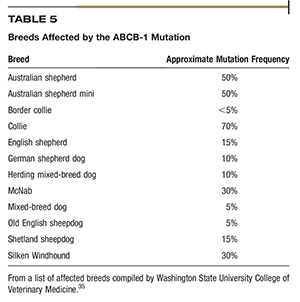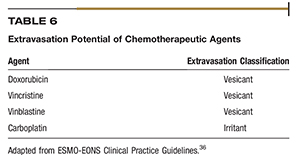Patient safety considerations
Click to access information on the Management of Chemotherapeutic Extravasation.
 Chemotherapeutic agents have a narrow therapeutic index and can lead to significant or fatal toxicity if overdosed. Errors in dose calculations and labeling as well as breed-specific sensitivities can lead to adverse events. Errors in dose calculations are responsible for a large portion of mistakes made in chemotherapy. In veterinary medicine, agents may be dosed in terms of milligrams/ kilogram (mg/kg) or milligrams per meter squared (mg/m2). These are easily confused and can lead to drastically different dose calculations. Prior to mixing chemotherapy drugs, calculations should be done by two individuals. The two calculated doses can then be compared and serve as a double check. The concentration of drug in mg/ml should also be double-checked.
Chemotherapeutic agents have a narrow therapeutic index and can lead to significant or fatal toxicity if overdosed. Errors in dose calculations and labeling as well as breed-specific sensitivities can lead to adverse events. Errors in dose calculations are responsible for a large portion of mistakes made in chemotherapy. In veterinary medicine, agents may be dosed in terms of milligrams/ kilogram (mg/kg) or milligrams per meter squared (mg/m2). These are easily confused and can lead to drastically different dose calculations. Prior to mixing chemotherapy drugs, calculations should be done by two individuals. The two calculated doses can then be compared and serve as a double check. The concentration of drug in mg/ml should also be double-checked.
The Washington State University College of Veterinary Medicine has extensively investigated the ABCB-1 gene (formerly known as MDR1), which is responsible for breed-specific variability in susceptibility to adverse events. The ABCB-1 gene codes for the production of p-glycoprotein (Pgp) pumps, which act to remove drugs from individual cells.34,35 The Washington State University College of Veterinary Medicine has published a list of breeds that have a high probability of an ABCB-1 gene mutation (Table 5). Many chemotherapy drugs, notably vincristine and vinblastine, are substrates for p-glycoprotein (Pgp) pumps and require a dose adjustment for that reason.34
When administering chemotherapy to an animal, proper restraint is very important in order to prevent drug extravasation. Staff members assisting with restraint should wear chemotherapy gloves and other appropriate PPE. Frequent monitoring of the injection site should be performed throughout the injection or infusion. Placement of a small-gauge IV catheter (e.g., 24 g, 22 g) will preserve vein viability and provide secure access. Although winged infusion sets are not as secure as IV catheters, they can be used for bolus injections of drugs such as vinca alkaloids, cyclophosphamide, and carboplatin. Winged infusion sets should never be used for severe vesicants, such as doxorubicin, or for lengthy infusions.
Venipuncture should entail a nicely seated, one-stick technique in order to avoid creating multiple holes within the vein wall that would allow the chemotherapy drug to leak into surrounding tissue. After chemotherapy administration is complete, apply gauze or alcohol swab to the injection site when removing the needle or catheter from the patient. This can help stabilize sudden movements of the exiting cannula as well as absorb possible residual chemotherapeutic agents contained within.
Because heparin can cause precipitation or inactivation of some chemotherapy agents, non-heparinized flushes are recommended. A 0.9% NaCl preparation is a standard fluid choice. Prime any lines with the 0.9% NaCl or other fluid prior to the addition or administration of chemotherapy.
Extravasations
 Extravasation is the process of liquid leaking into surrounding tissue, typically near the insertion site of a peripheral catheter. Drugs are classified according to their potential for causing damage as vesicant, irritant, or a nonvesicant.36 Table 6 lists the extravasation potential for five injectable chemotherapies used in veterinary medicine.36
Extravasation is the process of liquid leaking into surrounding tissue, typically near the insertion site of a peripheral catheter. Drugs are classified according to their potential for causing damage as vesicant, irritant, or a nonvesicant.36 Table 6 lists the extravasation potential for five injectable chemotherapies used in veterinary medicine.36
Most extravasation events can be prevented by a systematic, standardized, evidence-based approach to administration techniques. A trained and experienced staff will greatly decrease procedure-related extravasation risk factors. Fidalgo et al. outline a preventative protocol that may help minimize the risk of extravasations.36
The most common signs of extravasation are discomfort, pain, swelling, and redness at the injection site. Prolonged symptoms often progress to tissue ulcerations, blistering, and necrosis. Indications of an extravasation event include the absence of blood return from the catheter, bolus administration resistance, and failure of the infusion. If an extravasation event does occur, do not immediately remove the catheter. Rather, attempt to aspirate as much drug as possible and do not inject any fluid into the catheter. An extravasation mitigation protocol should be implemented as soon as possible.36



